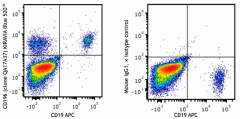- Clone
- QA17A37 (See other available formats)
- Regulatory Status
- RUO
- Other Names
- BN-1, CKR6, DCR2, CKRL3, DRY-6, GPR29, CKR-L3, CMKBR6, GPRCY4, STRL22, GPR-CY4
- Isotype
- Mouse IgG1, κ
- Ave. Rating
- Submit a Review
- Product Citations
- publications

-

Human peripheral blood lymphocytes were stained with anti-human CD19 APC and anti-human CD196 (CCR6) recombinant (clone QA17A37) KIRAVIA Blue 520™ (left), or mouse IgG1, κ KIRAVIA Blue 520™ isotype control (right).
| Cat # | Size | Price | Quantity Check Availability | Save | ||
|---|---|---|---|---|---|---|
| 399007 | 25 tests | $159 | ||||
| 399008 | 100 tests | $335 | ||||
CCR6, also known as CD196, is a chemokine receptor that is expressed on immature dendritic cells, B lymphocytes, and memory T cells. CCR6 binds CCL20, although members of the β defensin family also bind CCR6 with a lower affinity. CCR6 positive cells, and its ligand CCL20, have been detected in numerous organs, especially the secondary lymphoid organ. CCL20 is selectively made by the follicle-associated epithelium (FAE) overlying Peyers Patches (PPs) and isolated lymphoid follicles (ILFs). CCL20 contributes to the recruitment of CCR6-expressing B cells to these structures. In humans, CCR6 can function to mediate arrest of T cells on dermal endothelial cells and is highly expressed on T cells resident in both normal and psoriatic skin. CCR6 and/or CCL20 have been implicated in the pathogenesis of rheumatoid arthritis and inflammatory bowel disease. Human T cells that are able to produce IL-17 express CCR6. It suggests that CCL20 and CCR6 have a role in inflammatory diseases by recruiting Th17 cells to target tissues.
Product Details
Product Details
- Verified Reactivity
- Human
- Antibody Type
- Recombinant
- Host Species
- Mouse
- Formulation
- Phosphate-buffered solution, pH 7.2, containing 0.09% sodium azide and BSA (origin USA)
- Preparation
- The antibody was purified by affinity chromatography and conjugated with KIRAVIA Blue 520™ under optimal conditions.
- Concentration
- Lot-specific (to obtain lot-specific concentration and expiration, please enter the lot number in our Certificate of Analysis online tool.)
- Storage & Handling
- The antibody solution should be stored undiluted between 2°C and 8°C, and protected from prolonged exposure to light. Do not freeze.
- Application
-
FC - Quality tested
- Recommended Usage
-
Each lot of this antibody is quality control tested by immunofluorescent staining with flow cytometric analysis. For flow cytometric staining, the suggested use of this reagent is 5 µL per million cells in 100 µL staining volume or 5 µL per 100 µL of whole blood. It is recommended that the reagent be titrated for optimal performance for each application.
* KIRAVIA Blue 520™ has an excitation maximum of 495 nm, and a maximum emission of 520 nm.
KIRAVIA Blue™ 520 is a trademark of Sony. This product is subject to proprietary rights of Sony and is made and sold under license from Sony Corporation. This product is covered by U.S. Patent(s), pending patent applications and foreign equivalents.
Sony and the Sony logo are registered trademarks of Sony Corporation. - Excitation Laser
-
Blue Laser (488 nm)
- Application Notes
-
This recombinant antibody clone is derived from clone G034E3.
- RRID
-
AB_2922624 (BioLegend Cat. No. 399007)
AB_2922624 (BioLegend Cat. No. 399008)
Antigen Details
- Structure
- Chemokine receptor, GPCR, seven transmembrane receptor
- Distribution
-
Immature dendritic cells, B lymphocytes, memory T cells, Th17 cells
- Function
- Host defense, important for recruitment of B cells to secondary lymphoid organs, mediates arrest of T cells on dermal endothelial cells
- Ligand/Receptor
- CCL20 (MIP-3α)
- Molecular Family
- Cytokine/Chemokine Receptors
- Antigen References
-
1. Zaballos A, et al. 1996. Biochem. Bioph. Res. Co. 227:846.
2. Yang D, et al. 1999. Science 286:525.
3. MacDonald KG, et al. 2007. Am. J. Pathol. 170:1229.
4. Homey B, et al. 2000. J. Immunol. 164:6621.
5. Hirota K, et al. 2007. J. Exp. Med. 204:2803.
6. Singh SP, et al. 2008. J. Immunol. 180:214. - Gene ID
- 1235 View all products for this Gene ID
- UniProt
- View information about CD196 on UniProt.org
Related Pages & Pathways
Pages
Related FAQs
Other Formats
View All CD196 Reagents Request Custom Conjugation| Description | Clone | Applications |
|---|---|---|
| APC anti-human CD196 (CCR6) Recombinant Antibody | QA17A37 | FC |
| PE anti-human CD196 (CCR6) Recombinant Antibody | QA17A37 | FC |
| Purified anti-human CD196 (CCR6) Recombinant Antibody | QA17A37 | FC |
| KIRAVIA Blue 520™ anti-human CD196 (CCR6) Recombinant Antibody | QA17A37 | FC |
| PE/Cyanine5 anti-human CD196 (CCR6) Recombinant Antibody | QA17A37 | FC |
Compare Data Across All Formats
This data display is provided for general comparisons between formats.
Your actual data may vary due to variations in samples, target cells, instruments and their settings, staining conditions, and other factors.
If you need assistance with selecting the best format contact our expert technical support team.
-
APC anti-human CD196 (CCR6) Recombinant Antibody

Human peripheral blood lymphocytes were stained with anti-hu... -
PE anti-human CD196 (CCR6) Recombinant Antibody

Human peripheral blood lymphocytes were stained with anti-hu... -
Purified anti-human CD196 (CCR6) Recombinant Antibody

Human peripheral lymphocytes were stained with CD19 APC and ... -
KIRAVIA Blue 520™ anti-human CD196 (CCR6) Recombinant Antibody

Human peripheral blood lymphocytes were stained with anti-hu... -
PE/Cyanine5 anti-human CD196 (CCR6) Recombinant Antibody

Human peripheral blood lymphocytes were stained with anti-hu...
 Login/Register
Login/Register 













Follow Us